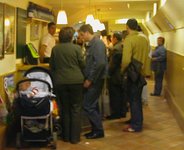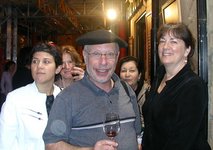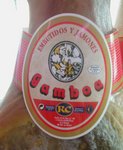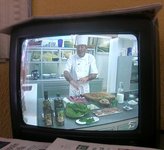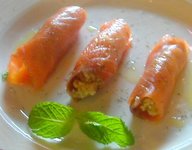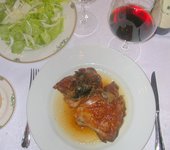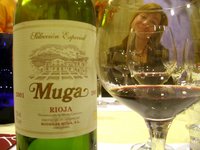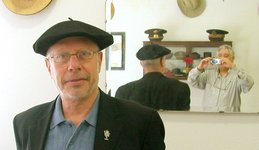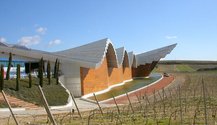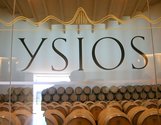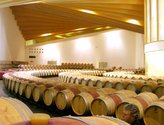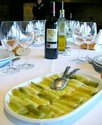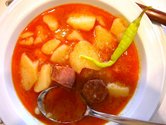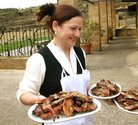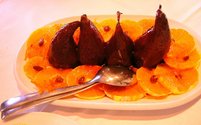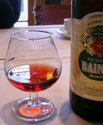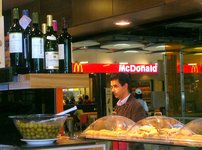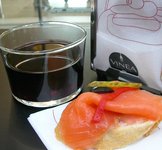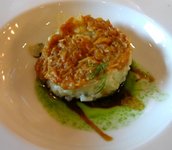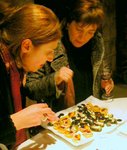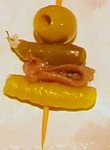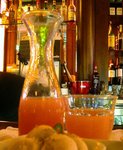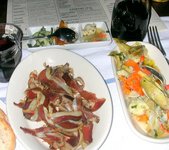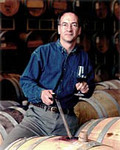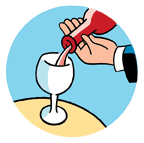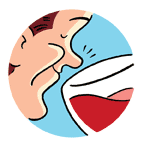March 31, 2006
Travel Notebook: Friday
From pensioners to babies in strollers, everybody goes tapas-hopping in Spain. Here in Logrono, capital of La Rioja and home to well over 100,000, it seems half of them are on the streets and in the bars this warm, moonless Friday night. At 9:30, we're on our way to a formal restaurant dinner but we join the locals on Calle Laurel for a quick drink at a tapas bar that specializes in garlicky mushrooms stuffed with shrimp.
That glazed expression? We've been up since dawn, working hard all day. Winery visits, elegant lunches, trade shows. That's the director of tourism of La Rioja province on my right, making sure we don't falter now that we're close to the finish line.
Scorecard: 2 whites, 5 reds, 1 corto (palate-cleansing mini-beer), 2 digestifs (1 herbal, 1 apple). Get the picture now?
March 30, 2006
Travel notebook: Thursday
Here in the Rioja, it's all about the ham. And the lamb. And the wine. A glass of tinto and a plate of pinxos starts with thinly sliced jamon. Anything less would be an insult. You think the TV chef is going to prepare those greens without a generous shot of sauteed jamon? Hah!
Vegetarians would have a hard time in Spain, country of meat-eaters, where the best jamon comes from pampered, free-range pigs fed nothing but acorns.
Not to slight the lamb. Cutlets grilled over vine clippings, hard to beat that. Today's lunch at La Cueva de Dona Isabela in Casalarreina starts with smoked salmon roulades, potato croquettes and codfish salad, then continues with crepe stuffed with blood sausage. Would be plenty anywhere else. Not here. Next up is massive chunks of roast lamb: complete foreleg, entire rib cage, the whole haunch. All very formal, too. The wine, a 2002 Puelles Crianza, is served in Riedel stems. And goes down very well.
Scorecard: 4 reds, 2 whites, 1 corto (short beer, hit the spot mid-morning in Haro).
March 29, 2006
Travel Notebook: Wednesday
Through a glass brightly: that's Sara Sampedro of La Rioja Tourism at a tasting. We're in the Rioja Alta now, with more substantial wines.
A gorra is just a cap, but a boina, that's the real thing, a genuine Basque beret. Bought one at a hat shop in the prosperous business district of Vitoria, the Basque provincial capital. Could fit right in, don't you think?
Scorecard: 2 whites, 7 reds. And a Sherry.
March 28, 2006
Travel notebook: Tuesday
Cantabrian massif shelters the Rioja Alavesa, keeping clouds at bay; sun shines bright. Ysios winery down the road from Laguardia designed by architectural wunderkind Santiago de Calatrava, is part of the Domecq conglomerate. Only fair: Spain's Ricardo Bofil does pioneering circular cellar for Lafitte-Rothschild, Ysios gets semi-circular cellar plus undulating roof and craggy prow that echo the nearby mountains.
Highlight is lunch at Remelluri winery. Leeks in garlicky vinaigrette. Patatas con chorizo, a hearty potato soup, is enlivened by a crunchy, green Ibarra pepper. Baby lamb chops, grilled over vine clippings, are fingerlickin' delicious. Pears poached in wine are brilliant purple, offset by fragrant orange slices. A cordial called Pacharan brings the feast to a sweet, cherry-berry conclusion.
Dinner novelty: white Txacoli made from hondarribi zuri, a tart, inoffensive, indigenous Basque variety. Pleasant enough with appetizers. Learn something every day.
Modest scorecard today. One white, three reds (all tempranillo), one liqueur.
March 27, 2006
Travel notebook: Monday
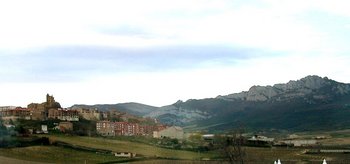
Fortress town of Laguardia, one of 19 medieval villages in the Rioja Alavesa
Arrive at Madrid airport mid-morning, steer left to avoid Egg McMuff and come upon elegant little wine bar. Copa of Rioja just the thing to wash down bite of smoked salmon.
On to northern industrial & banking city of Bilbao, reinvented as cultural & arts center. And food. Seven-course lunch highlighted by dreamy-creamy risotto topped with clams, crab and crayfish. Then down to the original LGA, 10th century Laguardia in shadow of Cantabrian mountains.
Tapas for dinner in remote cellar of subterranean El Fabulista winery. Novelty: Gilda, named for Rita Hayworth film (and pronounced with the Spanish aspirant H, hilda). Spicy pepper, salty anchovy, sour cornichon, piquant olive. Mmmm.
Today's wine scorecard: 2 whites, 7 reds, 1 sparkling.
March 26, 2006
Layover in Chicago
Arrive in Windy City a day early rather than take red-eye. Blue Line from O'Hare to Printer's Square, check into elegantly remodeled Hotel Blake.
Off in search of dinner, wander northward, stumble into newly opened wine bar called Quartino. Named for Italian quarter-liter carafe. Huge, lively spot, dozens of wines, dozens of small plates.
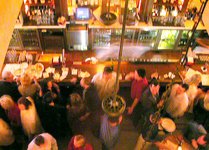
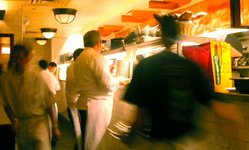
Bar scene at Quartino; Chef Coletta at the pass
Veteran chef John Coletta oversees bustling kitchen with admirable aplomb. Turns out owners also have Gibson's, the subject of an admiring Cornichon post on previous visit, in May of last year.
What a find! A Bellini ($8) with $2 cicchetti (Italian bar snacks) just like in Venice! Duck prosciutto ($4) cured on the premises! Neapolitan pizzas ($10), Italian cheeses ($4)!
Fast paced, high energy service, yet dishes presented with elegant, tasty garnishes. Copious portions, too. Bravissimo!
Quartino, 626 N. State St., Chicago, 312-698-5000
Hotel Blake, 500 S. Dearborn, Chicago, 312-986-1234
March 24, 2006
On the road again
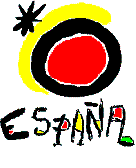
Off shortly to Spain for a weeklong tour of the Basque Country and La Rioja. Trip is sponsored by the Tourist Office of Spain, Iberia Airlines, and the two local tourism authorities. Muchos gracias!
On behalf of The International Vineyard, I'll be looking for cozy places to visit for a few days of informal wine touring. Dispatches as often as wi-fi conditions permit.
March 20, 2006
Plastic fish eggs
Vegfest (see earlier post as well) drew a predictable crowd of Birkenstocks to the Seattle Center Exhibition Hall couple of weekends ago, but Dale Sherrow wasn't among them. The owner of Seattle Caviar Company, he had the foresight to lock in the domain name Caviar.com long before Russian mafia types started looting Caspian Sea sturgeon, causing the price of beluga, osetra and sevruga to triple. His solution: caviar from the stable, government-controlled markets of Iran, which keeps the price under $200 an ounce. And alternate sources, like caviar from Montana's Yellowstone River paddlefish, a sustainable fishery priced at an almost-affordable $25 an ounce.

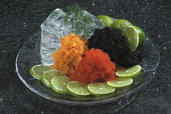
The real thing v. processed seaweed: you get what you pay for.
So what's one to make of that clutch of foodies at Helge Klausen's table, where he's promoting veget>arian Cavi-Art, an imitation caviar extruded from seaweed? Invented in Denmark, Cavi-Art comes in tiny spheres of black, red and yellow, and has a mouthfeel not unlike the finest caviar. It sells for less than two bucks an ounce!
The catch is that it while it looks like a duck and quacks like a duck, it doesn't taste anything like a duck. At best, it's mildly salty; at worst, it's edible plastic.
But that's precisely Klausen’s point: use it where taste is secondary to looks. As VP of NorSea, Cavi-Art's American distributor, he's not really selling to individual vegetarians. (What the hell was he doing at Vegfest in the first place? One can only wonder.) His real market is the food service industry, where even the appearance of "fancy" can be converted into higher-priced menu items. A dollop of Cavi-Art in an omelet, alongside a piece of smoked salmon or atop a seafood salad, costing next to nothing, is easily worth a couple of bucks extra on the customer's ticket.
The downside is that even caviar, the ultimate luxury food, is no longer immune to being ripped off. Unlike a diamond, caviar, it turns out, is not forever.
March 18, 2006
Eating of the green
Put on the Leprechaun suit and headed into the St. Patrick's Day fray, but Belltown felt like amateur night, full of 20-somethings from distant nabes crawling the pubs.
Tavernkeeper Carl Rogers made good on his promise to open Blarney Stone in time for the "event," such as it was. Harp on tap, served in a Bass go-cup. Hmm.
Best discovery of the night: the enormous and dense, meaty Bella di Cerignola olives from Italy's Puglia region, served as an appetizer at Marjorie. Bright, shiny green they were!
Blarney Stone, 1909 3rd Avenue
Marjorie, 2331 2nd Avenue, 206-441-9842
March 17, 2006
Wine kudos
We're quick--too quick, perhaps--to honor luminaries from afar. Distant stars glow seductively, it's true, but home-grown talent shines bright as well. Two examples: Tim O'Brien and Brian Carter.
O'Brien runs the admirable wine program at Salty's On Alki, which I praised here not all that long ago. Oh, the howls of derision I faced from supposedly serious connoisseurs! But O'Brien understands that wine is the actually most egalitarian of beverages. Now the reward: the Washington Wine Commission this week named O'Brien "Washington Sommelier of the Year" and Salty's "Restaurant of the Year." Bravo!
Carter has been a fixture in this state's wine industry for 25 years now and has already garnered all the top awards. What's next? The British wine mag Decanter reports this week that Carter is launching the first American "Euro-blend" winery: blends in the style of Bordeaux, the Rhone and Tuscany. Welcome news, though not yet reported locally. We'll keep you posted.
March 15, 2006
Here a blog, there a blog
The New York Times is downright schizophrenic. On the one hand, they've put their most popular columnists behind a TimesSelect firewall, forcing online readers to pay up or forego daily doses of Maureen Dowd, Thomas Friedman and Bob Herbert.
On the other hand, they're linking to free, staff-written food & wine blogs. Their ponderous restaurant critic, Frank Bruni, has been chruning out for about a month now. There's a promise of livelier writing from wine critic Eric Asimov's whose blog, The Pour launched earlier today.
Asimov promises to avoid the ritualized shorthand of tasting notes and concentrate instead on the pleasures of wine. Can't wait. Meantime, check out his links: online editions of Spectator and Parker are there, to be sure, along with some really idiosyncratic blogs. It's like being turned loose in a friend's wine cellar and finding all sorts of great bottles.
March 14, 2006
Gift horse
Is Starbucks out to sabotage the American work ethic? So it would seem: they'll be giving away coffee from 10 to noon tomorrow at more than 7,500 of their stores. Half a million 12-ounce Talls.
It would be churlish to point out that a Starbucks Tall is what others call a regular, or even a small. And it's just the brewed coffee. Those lattes, cappuccinos, Tazos and their ilk aren't part of the freebie.
Which is just as well. In fact, maybe it's time to make a list of things you shouldn't drink at Starbucks.
* The whole line of Frappuccino drinks: way too many calories from sugar and fat
* Chantico Chocolate Drinking Chocolate: icky, too sweet
* Those dreadful holiday concoctions: eggnog is a drink of its own, not a flavor!
* Last month's Cinnamon Swirl latte: muddy spice flavor
* This month's Marble Mocha macchiato: ugh! Like drinking a sticky Oreo through a chain link fence.
* The new Canned Iced Coffee: thin, watery and overly sweet (23 grams of sugar).
Isn't it time we recognized that Starbucks is no longer a coffee house but a candy store? An urban dessert bar called, er, Brokebucks? Sweet, seductive, even addictive, but ultimately unhealthy? Trouble is, we don't know how to quit you.
March 12, 2006
Eat your vegetables!
Vegfest 2006 brought close to 15,000 people to Seattle Center this weekend, where earnest young volunteers handed out samples from over 100 vegetarian vendors. Good news: not everything tasted like cardboard.
Best example: an outfit called Field Roast. Hadn't heard of them before. Not a fake animal meat like Tofukey or even Gardenburger, Field Roast has its roots in ancient Chinese baking techniques and Japanese Seitan. Seattle chef David Lee, working in an artisanal bakery ten years ago, added the bold flavors of European charcuterie--mustard, garlic, wine--to the mix. The result is a dense, rich and savory "grain meat."
Sampled the new line of Field Roast sausages--Italian, Mexican and Smoked Apple--all unbelievably tasty.
Lee runs Field Roast from a production kitchen in Georgetown and sells in 30 states (including PCC stores locally). Some time back, he started another company, Common Meals, to train homeless people as cooks; it's now run by a non-profit entity as FareStart. Clearly, a guy with his heart...and his tastebuds...in the right place.
March 11, 2006
Half a glass
Comes word from Brussels that negotiators for the European Union on one side of the table and Americans on the other have settled, sort of, their long-running dispute over geographic terms and wine-making methods that American exporters can use in Europe. Local or global, it's not as straightforward as it seems.
Three Washington wineries produced their own promotional poster. Bordeaux wine was a hit at an Alliance Francaise dinner celebrating French Language Week at the Art Institute of Seattle.
Champagne, Port, Sherry, etc., are clearly place names associated with distinct winemaking styles. Restricting their use on labels doesn't strike me as "protectionist;" far from it. Buying and drinking "local" has plenty of merits, too.
On the other hand, why should the EU object to imported wines from irrigated vineyards, or flavored with oak chips just because these techniques are forbidden to local producers?
Then again, why are the Californians upset that European governments provide direct subsidies to their wine industry? Water and energy, two of the most costly ingredients in agriculture, are artificially cheap in the US, but that massive hidden subsidy never gets acknowledged. If the Europeans hadn't given in, though, the Americans were threatening to make their lives miserable.
This way, we'll still be able to celebrate a very low-key Washington Wine Month even as we drink the delicious Chateau Marquet from Bordeaux ($12.95 at Champion Cellars); one assumes the French will get Gallo of Sonoma. Fair?
March 1, 2006
In like a lion
First three news items on the first day of March:
* Civics in America on the decline. Homer & Bart, one; freedom of speech, zero. That's depressing.
* Agriculture in America on the decline. Fruits & vegetables have less nutritional value than they used to. That's depressing.
* Psychiatry in America provides provides a discouraging response: a new skin patch called Emsam to treat depression. We're going to need a lot of those. As body armor, if nothing else.
Cornichons of the world, unite! We have nothing to lose but our vitamins! Assuming there's still some B12 left.
